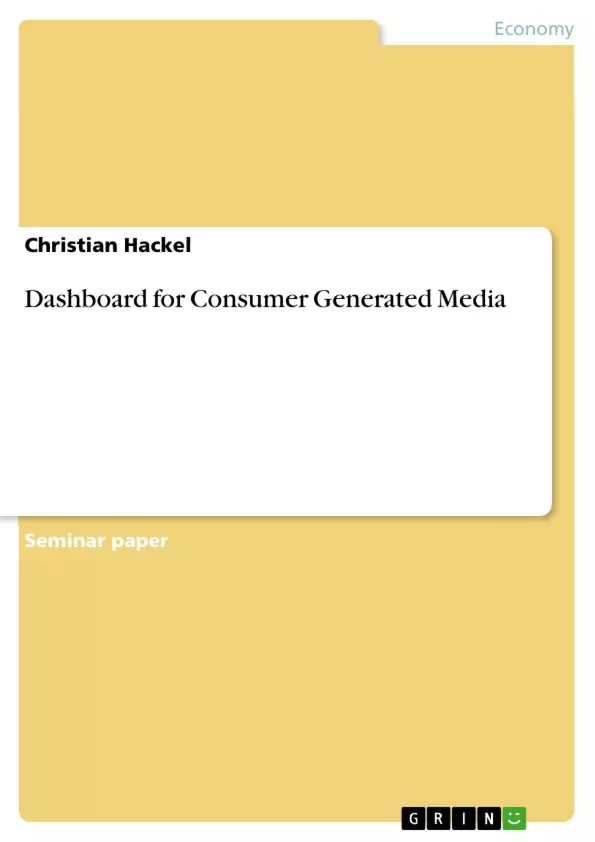In times of web 2.0 consumer generated content tends to have an even stronger influence on potential customers than marketing activities from the business side. The electronic world vastly accelerated the proliferation of information. Especially younger people often collect independent information about a product online, before actually puchasing it. Classic advertisement is predominantly considered to be biased. Due to this potential of autonomous information, it is crucial for companies to find effective ways to track, measure and interpret electronic Word-of-Mouth (e-WOM).
This paper presents ways to measure web based contents quantitatively and introduces appropriate indicators to provide the company with a full-spectrum-view of the consumer generated media. Moreover the interrelation between e-WOM and sales is shown. As a conclusion, suitable metrics are adapted to a practically usable dashboard for the management.
Inhaltsverzeichnis (Table of Contents)
- Word of Mouth
- Introduction
- WOM Dimensions
- WOM Volume
- WOM Valence
- Adapted Metrics for e-WOM
- WOM Volume-Related Metrics
- Return on Marketing Investment (ROMI) / Cost per Click
- Adapted Homepage Views and Page Impressions per Visit
- Adapted Google Hits
- Online-Forum Activity
- Adapted PageRank (APR)
- WOM Valence-Related Metrics
- Retention Rate
- Willingness to Pay
- Conversion Rate
- Willingness to Recommend (Net Promoter Score)
- Review Star Quantity
- Forum Valence
- Development of an e-WOM Dashboard
- The e-WOM Dashboard
- Utilization of the “right” Metrics
- Implications for Practical Intervention
- Matrix-Based Strategies
- APR-Based Strategies
- Summary
- Measuring e-WOM quantitatively
- Developing relevant indicators for a full-spectrum view of consumer generated media
- Analyzing the relationship between e-WOM and sales
- Creating a practical dashboard for management decision-making
- Utilizing key performance indicators (KPIs) for effective monitoring and strategic action
Zielsetzung und Themenschwerpunkte (Objectives and Key Themes)
This paper explores the significance of electronic Word-of-Mouth (e-WOM) in today's online world, where consumer-generated content heavily influences purchasing decisions. The paper aims to develop a comprehensive dashboard for tracking and interpreting e-WOM, demonstrating its value in measuring and managing consumer generated media.Zusammenfassung der Kapitel (Chapter Summaries)
The paper begins by highlighting the importance of monitoring e-WOM in today's digital landscape, where consumer-generated content is a powerful influence on purchasing decisions. It emphasizes the need for companies to effectively track, measure, and interpret online reviews and discussions.
Chapter 2 discusses the crucial role of dashboards in providing management with a concise and easily understandable overview of key performance indicators (KPIs). This chapter argues that dashboards are essential for making informed decisions by presenting important data in a visual and intuitive manner.
Chapter 3 focuses on the various dimensions of e-WOM, including WOM volume and valence. The paper explores how different aspects of online conversations, such as the sheer volume of mentions and the overall sentiment expressed, can be measured and interpreted effectively.
Chapter 4 delves into a detailed examination of metrics used to measure both WOM volume and valence. These metrics encompass a range of indicators, including return on marketing investment (ROMI), adapted homepage views, online forum activity, and adapted PageRank.
Chapter 5 outlines the development of a comprehensive e-WOM dashboard, which provides a consolidated view of all key metrics and performance indicators. This chapter emphasizes the importance of selecting the right metrics to ensure the accuracy and effectiveness of the dashboard.
Chapter 6 examines the practical implications of using an e-WOM dashboard for strategic decision-making. The chapter explores various intervention strategies based on matrix analysis and PageRank, highlighting the potential for proactive responses to changing market dynamics.
Schlüsselwörter (Keywords)
This paper centers on electronic Word-of-Mouth (e-WOM) and its impact on business decision-making. Key concepts explored include: consumer-generated media, dashboard development, key performance indicators (KPIs), metrics for e-WOM measurement, and strategic intervention strategies.- Arbeit zitieren
- Christian Hackel (Autor:in), 2009, Dashboard for Consumer Generated Media, München, GRIN Verlag, https://www.grin.com/document/126264



